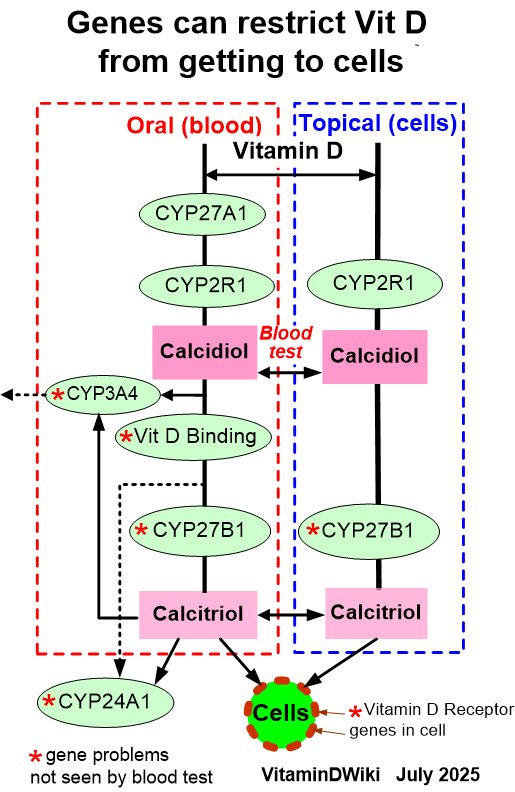Twice as likely to survive Colorectal Cancer if had good level of Vitamin D Binding Protein
Prediagnostic circulating concentrations of vitamin D binding protein and survival among colorectal cancer patients
Proceedings: AACR Annual Meeting 2019; March 29-April 3, 2019; Atlanta, GA DOI: 10.1158/1538-7445.SABCS18-3297
Chen Yuan, Mingyang Song, Brian M. Wolpin, Jeffrey A. Meyerhardt, Shuji Ogino, Bruce W. Hollis , Andrew T. Chan, Charles S. Fuchs, Kana Wu, Molin Wang, Stephanie A. Smith-Warner, Edward L. Giovannucci and Kimmie Ng
 click on chart for detials
---
* Prostate cancer 3X more likely to be lethal if both low vitamin D and poor Vitamin D Binding gene – March 2020
* Vitamin D Binding Protein masks how much Vitamin D gets to tissues – May 2019
* Poor Vitamin D response 4X more likely if poor Vitamin D binding proteins - July 2019
* 10 reasons for poor response to Vitamin D (race, binding protein, etc.) – Nov 2017
* Colorectal cancer is associated with Vitamin D (17 meta-analyses so far) – July 2018
1. Cancer - Colon category starts with the following
{include}
---
1. # Items in both categories CCR and Vitamin D Binding Protein are listed here:
{category}
click on chart for detials
---
* Prostate cancer 3X more likely to be lethal if both low vitamin D and poor Vitamin D Binding gene – March 2020
* Vitamin D Binding Protein masks how much Vitamin D gets to tissues – May 2019
* Poor Vitamin D response 4X more likely if poor Vitamin D binding proteins - July 2019
* 10 reasons for poor response to Vitamin D (race, binding protein, etc.) – Nov 2017
* Colorectal cancer is associated with Vitamin D (17 meta-analyses so far) – July 2018
1. Cancer - Colon category starts with the following
{include}
---
1. # Items in both categories CCR and Vitamin D Binding Protein are listed here:
{category}
Higher total 25-hydroxyvitamin D [25(OH)D] levels are associated with an improvement in survival among colorectal cancer (CRC) patients, but the relationships between plasma vitamin D binding protein (VDBP), bioavailable or free 25(OH)D, and CRC survival remain unknown. In two prospective cohort studies, the Health Professionals Follow-Up Study and the Nurses’ Health Study, we examined the association between prediagnostic plasma levels of VDBP, bioavailable 25(OH)D, and free 25(OH)D and survival among 604 participants diagnosed with CRC between 1991 and 2011. Plasma 25(OH)D and VDBP were directly measured, while bioavailable and free 25(OH)D were calculated using a validated formula based on total 25(OH)D, VDBP, and albumin levels. Cox proportional hazards models were used to estimate hazard ratios (HRs) for overall and CRC-specific mortality, adjusted for other prognostic markers and potential confounders.
During the follow-up, there were 279 deaths, 177 of which were due to CRC (63%). Higher VDBP levels were associated with a significant improvement in overall and CRC-specific survival (Ptrend=0.005 and 0.02, respectively).
Compared to patients in the lowest quartile, those in the highest quartile of VDBP had a multivariable-adjusted HR of 0.61 (95% confidence interval [CI], 0.42-0.89) for overall mortality and 0.56 (95% CI, 0.35-0.92) for CRC-specific mortality . The results remained similar after further adjustment for total 25(OH)D levels. In contrast, no association with overall or CRC-specific mortality was observed for bioavailable or free 25(OH)D levels. In conclusion, higher prediagnostic plasma VDBP levels were associated with improved survival among CRC patients. The clinical utility of VDBP as a prognostic marker warrants further exploration, as well as research into underlying mechanisms of action.
